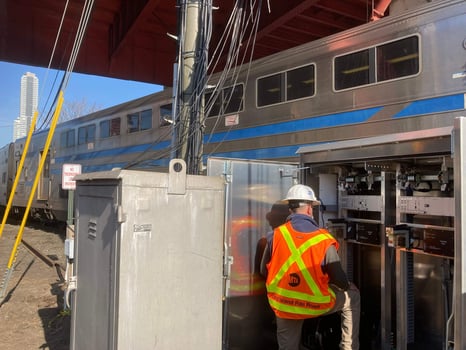Wayside Signal Applications | Axel Counting & Train Control Network
Axle counting systems are ideal for a variety of wayside signal and train control applications. Examples of common applications include, but are not necessarily limited to:- Overlay circuits for applications where traditional track circuits are already in place.
- Interlocking systems
- Positive train control functions, such as “red light overrun” detection.
- Switch protection functions.
- Interlocking and approach signaling at lift and swing bridges.
- Trap circuits at steel-deck bridges.
- Insulated joints are eliminated.
- Shunts, diodes, and bonds are eliminated.
- Shunting sensitivity issues are eliminated.
- Rusty rail does not affect performance.
- Problems with passenger equipment detection failures are eliminated.

A Pintsch axel counting system being installed in New York State. This system provides service for both grade crossing protection and wayside signal function on a transit agency. Axle counting provides a preferred solution for embedded track, particularly during winter conditions when snow melting chemicals penetrate track and structure.
A transit agency in Canada required the design and construction of an interlocking plant in a tunnel.Within the narrow confines and limited dynamic envelope of the tunnel location, a double track main line split into two double track subdivisions. The use of track circuits proved problematic, so Pintsch North America provided the necessary solution. The flexibility of an axle counting system and the fact that it eliminates the requirement for insulated joints, shunts and similar track components proved the advantage. After three years of operation, our engineering department received a call from the customer requesting information. Because the axle counting system had worked flawlessly for several years, the signalman responsible for its maintenance couldn’t recall how it worked and required a repeat training class. As one transit employee commented “it works so well, we sort of forget about it.”
Bridges:A class one railroad in the United States installed Pintsch axle counting systems on both swing bridges and steel deck bridges in locations where track circuits proved extremely unreliable. The axle counting systems provided a “virtual track circuit,” which eliminated shunting problems while simplifying the configuration of the signal system.
Wayside signaling:Pintsch axle counting technology has been deployed on several high-profile transit systems in North America. Included in these networks one will find interlocking systems, cross-overs, and red-light-overrun detection circuits operating on the axle-counting principle. Pintsch can design customized systems and applications to solve any wayside signaling problem.
Overlays:A railroad in Michigan required the installation of a highway grade crossing system close to the limits of an interlocking system. This new installation would have required that the approach circuit penetrate the track circuits associated with the interlocker. Pintsch axle counting allowed for the installation of an approach circuit atop the existing track circuit without interference. Absolutely no changes to the interlocker were required.The examples are too numerous to mention in their entirety. Contact Pintsch North America with your requirements and we will develop the needed solution for you!

Pintsch axle counting systems in service in New York City. These systems offer the reliability and accuracy to properly respond to the high volume of train movements typical of a busy rail transit system!

This innocuous looking relay house on a class one railroad holds a solution to limited wayside train control functions on dark territory. A Pintsch axle counting system providing the necessary train detection functions for switch control and protection at a siding.

